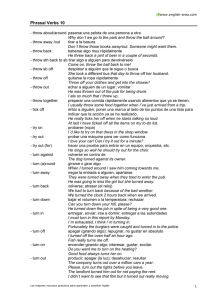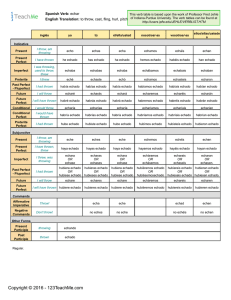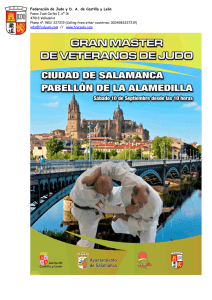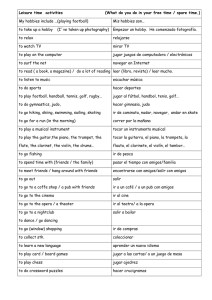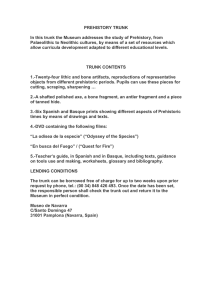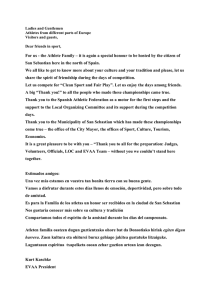sequences of errors in the judo throw morote
Anuncio
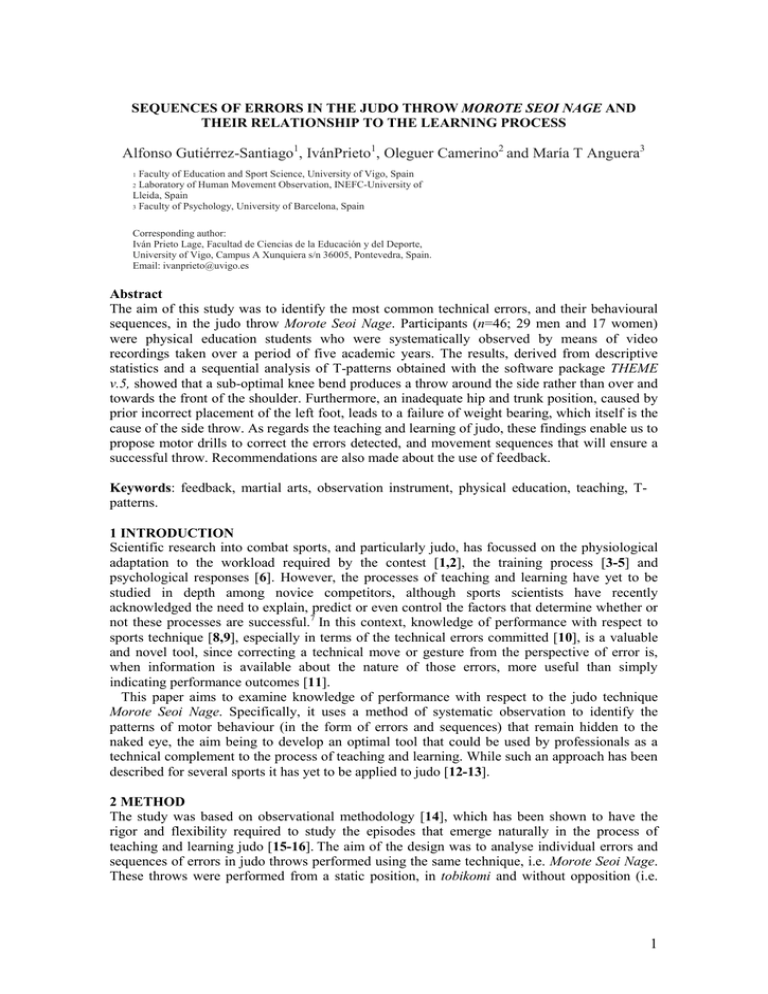
SEQUENCES OF ERRORS IN THE JUDO THROW MOROTE SEOI NAGE AND THEIR RELATIONSHIP TO THE LEARNING PROCESS Alfonso Gutiérrez-Santiago1, IvánPrieto1, Oleguer Camerino2 and María T Anguera3 Faculty of Education and Sport Science, University of Vigo, Spain Laboratory of Human Movement Observation, INEFC-University of Lleida, Spain 3 Faculty of Psychology, University of Barcelona, Spain 1 2 Corresponding author: Iván Prieto Lage, Facultad de Ciencias de la Educación y del Deporte, University of Vigo, Campus A Xunquiera s/n 36005, Pontevedra, Spain. Email: [email protected] Abstract The aim of this study was to identify the most common technical errors, and their behavioural sequences, in the judo throw Morote Seoi Nage. Participants (n=46; 29 men and 17 women) were physical education students who were systematically observed by means of video recordings taken over a period of five academic years. The results, derived from descriptive statistics and a sequential analysis of T-patterns obtained with the software package THEME v.5, showed that a sub-optimal knee bend produces a throw around the side rather than over and towards the front of the shoulder. Furthermore, an inadequate hip and trunk position, caused by prior incorrect placement of the left foot, leads to a failure of weight bearing, which itself is the cause of the side throw. As regards the teaching and learning of judo, these findings enable us to propose motor drills to correct the errors detected, and movement sequences that will ensure a successful throw. Recommendations are also made about the use of feedback. Keywords: feedback, martial arts, observation instrument, physical education, teaching, Tpatterns. 1 INTRODUCTION Scientific research into combat sports, and particularly judo, has focussed on the physiological adaptation to the workload required by the contest [1,2], the training process [3-5] and psychological responses [6]. However, the processes of teaching and learning have yet to be studied in depth among novice competitors, although sports scientists have recently acknowledged the need to explain, predict or even control the factors that determine whether or not these processes are successful.7 In this context, knowledge of performance with respect to sports technique [8,9], especially in terms of the technical errors committed [10], is a valuable and novel tool, since correcting a technical move or gesture from the perspective of error is, when information is available about the nature of those errors, more useful than simply indicating performance outcomes [11]. This paper aims to examine knowledge of performance with respect to the judo technique Morote Seoi Nage. Specifically, it uses a method of systematic observation to identify the patterns of motor behaviour (in the form of errors and sequences) that remain hidden to the naked eye, the aim being to develop an optimal tool that could be used by professionals as a technical complement to the process of teaching and learning. While such an approach has been described for several sports it has yet to be applied to judo [12-13]. 2 METHOD The study was based on observational methodology [14], which has been shown to have the rigor and flexibility required to study the episodes that emerge naturally in the process of teaching and learning judo [15-16]. The aim of the design was to analyse individual errors and sequences of errors in judo throws performed using the same technique, i.e. Morote Seoi Nage. These throws were performed from a static position, in tobikomi and without opposition (i.e. 1 technical work). The various dimensions taken into account by the analysis are reflected in the category system shown in Table 1. On the basis of this design a series of decisions were made regarding the participants, the observation and recording instruments used, and the analytic procedure. Broadly speaking, Morote Seoi Nage is a throw technique performed with the arms spread and in which Tori (the person who performs the action) throws Uke (the person thrown) in a forward direction. The move begins with the two judokas facing one another and using a normal grip. The thrower then turns in the vertical axis and, without releasing his grip, takes the weight of his opponent’s body on his back and throws him over his shoulder. Figure 1. Arborescence of Morote Seoi Nage. Note. The area highlighted in grey has not been analysed in this study. Participants were physical education students (n=46, 29 men and 17 women; M=24.56 years; SD=2.73) studied over a period comprising five academic years (from 2003/2004 to 2007/2008). They all gave their written informed consent to be filmed on video. The number of recordings made was distributed equally over the five academic years. The observation instrument developed for this study was the SOBJUDO-MS (see Table 1), which combines field formats with category systems [17-18]. The criteria of the SOBJUDO-MS are consistent with the objectives of the study, i.e. technical errors when performing the throw. The technical model used for both the process of teaching/learning the throw and for its observation was based on the approach of the Kodokan school [19]. The SOBJUDO-MS is consistent with the proposed observational design, it being multidimensional and based on the following criteria: grip, off-balance, right foot position, right arm position, hip position, trunk position, left foot position, leg action, load action, throw stage, control stage, rebalancing and global performance. Each of these dimensions gives rise to a system of categories that fulfil the requirements of exhaustiveness and mutual exclusivity (E/ME). 2 Table 1. The observation instrument SOBJUDO-MS. Criterion Code Description AGR Tori grips Uke’s judogi with his left hand around the middle section of the arm. GRIP Tori does not put Uke off balance in the first part of the technique. His arms maintain the initial NOB grip and serve only to accompany the action. OFF-B. The frontal off-balancing action and the subsequent displacement are performed in a DOB discontinuous way. Tori positions incorrectly his right foot in the launching of the technique (i.e. the opening IRFP move), after turning in the vertical axis. The correct position is on the inside of where Uke’s R.F.P. foot is placed. FAS While performing the technique Tori’s forearm is in contact with Uke’s sternum. R.A.P. There is a gap (sagittal plane) between the posterior part of Tori’s left hip and the anterior part IHP H.P. of the left-hand side of Uke’s body during the second stage of the throw. T.P. ITP L.F.P. ILFP LE.A. INSQ LO.A. NLHL NSIM STH IAT T.S. ITFL ITTU FNC C.S. KTB FACC RRF REB. RLF GLOB. SLEX There is a gap (sagittal plane) between the posterior left-hand side of Tori’s trunk and the anterior part of the left-hand side of Uke’s body during the second stage of the throw. Tori positions incorrectly his left foot in the launching of the technique, after turning in the vertical axis. The correct position is on the inside of where Uke’s foot is placed. Tori fails to bend his knees sufficiently in the launching of the technique, as his hip is not located at the level of Uke’s thighs. Tori fails to take Uke’s weight on his back, or instead does so over his hip. Tori first bends and straightens his knees, and then bears Uke’s weight with his body, in other words, the two actions are not simultaneous. Tori throws Uke around the side of his body instead of over the top and toward the front of his shoulder. During the final stage of the throw Tori’s arms produce insufficient force when throwing Uke’s body to the floor. Insufficient trunk flexion at the end of the throw (Tori maintains a position of between 10º and 60º). Tori fails to turn his trunk enough in the guiding stage of the technique (i.e. positioning and control of the throw towards the floor). During the final stage of the technique Tori performs no left-hand action and therefore fails to control the fall of his adversary’s body. During the final stage of the throw Tori bends his trunk between 90º and 110º and maintains this position once the technique is complete. During the guiding stage Tori uses his right arm to accompany Uke’s fall to the floor. After performing the throw Tori loses his balance. In order to regain it he steadies himself using his right leg. Upon completion of the technique Tori loses his balance, which he regains by steadying himself with his left foot. The throw is executed slowly and without any continuity. The performance of the technique under study (the Morote Seoi Nage) was filmed after a training period lasting approximately four months, involving three hours of practice per week. A total of 17 throws were learnt. Data were gathered by means of two digital video cameras (JVC GZ-MG21E). The recordings of the different throws were then edited using the video editing suite Pinnacle Studio v.12. The recording instrument used for the observation was the software package Match Vision Studio Premium v.1.0 [20]. This is an interactive multimedia program that enables the user to visualise and register digitalised video recordings on the same computer screen. The program is highly flexible and allowed us to introduce all the codes corresponding to each of the changing criteria of the SOBJUDO-MS observation instrument, thereby producing a record of their appearance in succession. After recording all the relevant technical manoeuvres the program produces an Excel file containing the successive configurations formed by the lines of codes that have changed, with their temporality and duration expressed in frames (25 frames is equivalent to 1 s). The quality of the data was assessed by means of Cohen’s kappa, with values of this coefficient above 0.8 being regarded as indicative of reliability. This test was conducted using the software SDISGSEQ v.4.2 [21], and yielded a kappa value of 0.89. Having ensured the quality of the recorded 3 data an initial descriptive analysis of the frequency and percentage of occurrence of technical errors was then conducted. The resulting .xls files, obtained using Excel and which provide frequencies for all the occurrences of recorded codes, were then transformed successively in order to enable various analyses to be carried out. The codes of the SOBJUDO-MS observation instrument were then exported to the THEME software [22] with the aim of detecting temporal patterns (T-patterns) [23]. A temporal pattern is essentially a combination of events that occur in the same order, with the consecutive time intervals between consecutive pattern components remaining relatively invariant, it being assumed, as a null hypothesis, that each component is independently and randomly distributed over time. Figure 1 illustrates how the temporal relationship between A and B, defined as a critical interval, lies at the heart of the algorithms used to detect T-patterns [23]. These T-patterns, which were obtained by means of the algorithm incorporated within THEME v.5 [23], can help to reveal hidden structures and unobservable aspects in sports techniques. The application of this software has proved to be highly effective for studying team, individual and combat sports [24-26]. Figure 2. Even with extremely simple data the most regular Tpatterns may be hard to spot. The T-pattern on the lower axis is present in the upper axis, where the occurrences of w and k make it hard to see. The defining characteristics of T-patterns are apparent: fixed order of components occurring with similar distances between them at each pattern occurrence. The binary tree structure indicates the bottom-up detection strategy, which may or may not reflect an inherent hierarchical structure [23]. 3 RESULTS In accordance with the above description (Table 1) of the errors observed when participants performed the Morote Seoi Nage the following table (Table 2) shows the frequency and percentage of these technical errors in the study sample (n=46). Table 2. Frequency and percentage of technical errors in Morote Seoi Nage. Error Frequency Grip AGR 22 Off-balance NOB 29 DOB 3 Right foot position IRFP 26 Right arm position FAS 9 Hip position IHP 11 Trunk position ITP 25 Left foot position ILFP 33 Leg action INSQ 32 Load action NLHL 29 NSIM 3 Throw stage STH 32 IAT 14 ITFL 8 ITTU 5 Control stage FNC 11 KTB 10 FACC 32 Regaining balance RRF 15 RLF 5 Global SLEX 2 Percentage 47.8 63 6.5 56.5 19.6 23.9 54.3 71.3 69.6 63 6.5 69.6 30.4 17.4 10.9 23.9 21.7 69.6 32.6 10.9 4.3 4 Table 2 shows that the most common errors were: the lack of an initial action using both arms to put the adversary off balance (NOB); inadequate positioning of the trunk (ITP) and the feet (IRFP and ILFP) after turning in the vertical axis; a sub-optimal leg bend (INSQ); the failure of Tori to take Uke’s weight on his back (NLHL); throwing the adversary’s body around the side (STH); and Tori’s use of his right arm to accompany Uke’s fall to the floor at the end of the move (FACC). There were no significant differences (p>.05) in the number of errors detected according to the academic year. The possibility of differences between male and female participants as regards the errors observed when performing the Morote Seoi Nage was tested by comparing means with a MannWhitney U test. This showed that none of the differences was statistically significant (p>.05). The errors produced by participants (novices) when performing the Morote Seoi Nage were examined in greater depth by means of the THEME software (Magnusson, 1996, 2000). This program is able to detect any temporal patterns present in the data, which in this case were sequential. The analysis of these T-patterns revealed a series of important relationships associated with the emergence of sequential errors. Figure 3. First T-pattern of Morote Seoi Nage. Firstly, and as the T-pattern shows (Fig. 3), inadequate foot placement (IRFP and ILFP) leads to an incorrect positioning of both the hip (IHP) and the trunk (ITP). Similarly, these two errors are related to a sub-optimal knee bend (INSQ), which in turn is linked to Tori’s subsequent failure to bear the adversary’s weight correctly (NLHL). The inertia of this incorrect action results in Uke’s body being thrown around the side (STH) rather than over and towards the front of the shoulder. As indicated by the first category of this T-pattern the whole of this manoeuvre begins with an incorrect off-balancing technique at the start (NOB), which is normally associated with a lack of traction of both arms. Also noteworthy is the strong relationship between a sub-optimal knee bend and the subsequent side throw (INSQ-STH), this being important insofar as it directly influences the motor action of the throw. The results show that this occurred on 28 of the 32 occasions in which a sub-optimal knee bend was observed. 5 4 DISCUSSION Common errors among the participants studied were inadequate knee bending in the launching stage of the Morote Seoi Nage, a failure to bear Uke’s weight or doing so over the hip rather than the back, and throwing Uke’s body around the side. Other typical errors committed by Tori were incorrect foot placement after the initial movement or an inadequate hip/trunk position after turning in the vertical axis. Furthermore, many participants failed to grip Uke’s right sleeve properly in the pre-action (or preparatory) stage of the technique. They also failed to put their opponent off balance in the right way, used their right arm to accompany their rival’s fall, and used one or both feet in order to regain their balance after performing the throw. Despite the lack of scientific research on technical errors in judo it should be noted that the most prestigious authors associated with the sport do, in their descriptions of judo technique, reflect upon the key aspects or the most common errors made. Interestingly, the points they make, which are based on their personal and professional experience, often coincide with the typical errors revealed by the present study. For example, some authors [27,28] have pointed out the importance of using both arms in the direction of the right anterior diagonal in order to perform the initial off-balancing manoeuvre. Similarly, Daigo [27] and Ohlenkamp [29] both highlight the need for Tori, after turning in the vertical axis, to place his feet on the inside of where Uke’s feet are. With respect to other typical errors associated with this throw a number of authors [4,27,30,31] state that when performing the Morote Seoi Nage it is essential that Tori bends his knees sufficiently. Another error committed by most of the judokas was the failure to bear Uke’s weight, or to do so over the hip rather than the back, which subsequently leads to a throw around the side of Tori’s body instead of over and towards the front of the shoulder. Some classic manuals do point out the importance of taking the opponent’s weight on the back prior to initiating the final stage of the throw [4,32,33]. However, in manuals for novices this skill is rarely described [34]. As regards the throw around the side of Tori’s body, it should be acknowledged that such errors may simply be due to a lack of experience. The analysis of the different throws also revealed that another common error was for Tori to accompany Uke’s body with his right arm until the latter’s back hit the floor. The literature consulted makes no mention of this technical defect, although this error is most likely due to Tori’s lack of confidence about throwing the opponent, since the participants here had limited practical experience in judo. The tree diagrams show that a sub-optimal knee bend leads Tori to bear his adversary’s weight over the hip instead of the back, which in turn results in a throw around the side of Tori’s body rather than over and towards the front of the shoulder. Furthermore, if, when performing the manoeuvre, Tori leaves a gap between the posterior part of his left hip/back and the anterior part of the left side of Uke’s body he tends to bear Uke’s weight over his hip or even fails to take the load at all. The most important sequence observed in the tree diagrams is also described in the extant literature. For example, Taira, Herguedas and Román [30] state that “the knees should be bent so as to make it easier to take Uke’s weight over the right shoulder” (p. 207), an idea that is supported by other authors [27,31]. In the same vein, Kawaishi [35] recommends placing the feet to the inside of where the adversary’s are, as a failure to do so will make it very difficult to attain an adequate hip position, which is regarded as essential for a correct performance of the manoeuvre in motor terms. Similarly, Daigo [27] states that the manoeuvre as a whole is greatly hindered if there is a gap between the bodies of the two adversaries, as this makes it difficult for Tori to take the weight of Uke’s body and subsequently throw it. These aspects are also illustrated by the most representative tree diagrams of the technique as studied here. Finally, mention should be made of the sequence described by the judo master Kano [32], which concerns one of the most significant error chains detected through the tree diagrams: “put your opponent off balance from the front or along the right anterior diagonal, take his weight on your back and throw him over your shoulder” (p. 67). 6 5 CONCLUSIONS In order to avoid the errors detected here there are a number of key points to note when performing the Morote Seoi Nage: 1) grip with the left hand Uke’s right sleeve at the level of the elbow or the forearm; 2) put Uke off balance from the front, pulling him towards you with both hands; 3) place both feet inside the adversary’s feet (frontal plane) and more or less at the same level (sagittal plane); 4) close contact should be established between the posterior part of Tori’s hip/trunk and the anterior part of Uke’s; 5) bend the knees during the launching stage; 6) bear the weight of the adversary’s body on the back; 7) throw Uke over and towards the front of the shoulder; and 8) control Uke’s fall with the left arm, maintaining an upright position without moving the feet. To conclude, the teaching and learning of this judo throw could be improved by paying special attention to the following movement sequences that enable it to be performed correctly: 1) bending the knees makes it easier for Tori to take Uke’s weight on his back, which in turn enables the latter’s body to be thrown over and towards the front of the shoulder; and 2) it is easier for Tori to take Uke’s weight on his back if he first ensures that the posterior part of his hip/trunk is in close contact with the anterior part of Uke’s. 5.1 PRACTICAL IMPLICATIONS In light of the present results a number of strategies based on knowledge of performance can be proposed to help improve both the teaching and learning of the Morote Seoi Nage manoeuvre. For example: 1) When demonstrating the technical aspects of this throw the student’s attention should be drawn towards the key points highlighted by this study. From a more theoretical point of view it could be useful for coaches to incorporate the use of video or other images that highlight the fundamental aspects of the technique, as well as the most common errors detected here. At all events, teachers or coaches should focus only on the most relevant aspects. 2) Design tasks or drills that focus the student’s attention on the most significant errors and movement sequences detected in this study. 3) Draw up observation/evaluation sheets based on the category system used in this research. Students could work in groups of three, with one of them acting as an observer of the other two, who perform the throw. The former student would therefore conduct an observational analysis using the evaluation sheet, noting the errors made and providing immediate feedback. The same approach could also be used with video recordings of the throws performed, thereby enabling the observational analysis to be conducted after the event. 4) Improve the communication between coaches and students by providing more precise feedback after a throw is performed in training. In this regard we recommend that coaches focus initially on the most significant errors and sequences identified in this study, leaving any others for a later stage of training. It is also helpful to focus on the key aspects so as avoid overloading students with information. At all events, the results of this study can serve as the basis for different kinds of feedback (verbal, verbal with a visual demonstration or verbal with tactile help), which should be positive in nature. ACKNOWLEDGMENTS We gratefully acknowledge the support of the Spanish government project Avances tecnológicos y metodológicos en la automatización de estudios observacionales en deporte (Dirección General de Investigación, Ministerio de Ciencia e Innovación), Grant PSI200801179. 7 REFERENCES 1 Degoutte F, Jouanel P, Filaire E. (2003). Energy demands during a judo match and recovery. Brit J Sport Med 2003;37:245-49. 2 Houvenaeghel M, Bizzari C, Giallurachis D, et al. Continuous recording of heart rate during specific exercises of judo. Sci Sports 2005;20:27–32 3 Artioli GG, Iglesias RT, Franchini E, et al. Rapid weight loss followed by recovery time does not affect judo-related performance. J Sport Sci 2010;28(1):21-32. 4 Blais L, Trilles F, Lacouture P. Three-dimensional joint dynamics and energy expenditure during the execution of a judo throwing technique (Morote Seoi Nage). J Sport Sci 2007;25(11):1211-20. 5 Calmet M, Ahmaidi S. Survey of advantages obtained by judoka in competition by level of practice. Percept motor skills 2004;99:284-90. 6 Greenlees I, Jones S, Holder T, et al. The effects of self-handicapping on attributions and perceived judo competence. J Sport Sci 2006;24(3):273-80. 7 Liu J, Lee AN, Fang Y. The effect of three types of knowledge of performance on the acquisition and transfer of a golf putting skill. Res Q Exercise Sport 2004;75(1):A48A49. 8 Laguna PL. Task complexity and sources of task-related information during the observational learning process. J Sport Sci 2008;26(10):1097-113. 9 Mononen K, Viitasalo JT, Konttinen N, et al. The effects of augmented kinematic feedback on motor skill learning in rifle shooting. J Sport Sci 2003;21(10):867-76. 10 Helsen W, Gilis B, Weston M. Errors in judging "offside'' in association football: Test of the optical error versus the perceptual flash-lag hypothesis. J Sport Sci 2006;24(5):521-28. 11 Schmidt R, Lee TD. Motor control and learning. Champaign: Human Kinetics; 2005. 12 Borrie A, Jonsson GK, Magnusson MS. Temporal pattern analysis and its applicability in sport: An explanation and exemplar data. J Sport Sci 2002;20:845-52. 13 Camerino O, Chaverri J, Anguera MT, et al. Patrones de juego en los deportes de equipo: fútbol, balonmano y baloncesto [Patterns of play in team sports: soccer, handball and basketball]. In: X Congreso de Metodología de las Ciencias Sociales y de la Salud. Libro de resumenes [Proceedings of the X Congress of Methodology in the Social and Health Sciences]. Barcelona: Servicio de Publicaciones de la Universidad de Barcelona; 2008. p. 62-3. Spanish. 14 Anguera MT, Blanco-Villaseñor A, Losada JL. Diseños Observacionales, cuestión clave en el proceso de la metodología observacional [Observational designs, a key aspect in the process of observational methodology]. Metodología de las Ciencias del Comportamiento 2001;3(2):135-61. Spanish. 15 Anguera MT, Jonsson GK. Detection of real-time patterns in sport: Interactions in football. Int J Comp Sci Sport 2003;2(2):118-21. 16 Bloomfield J, Jonsson GK, Polman R, et al. Temporal patterns analysis and its applicability in soccer. In: Anolli L, Duncan S, Magnusson M, Riva G, editors. The hidden structure of social interaction. From Genomics to Culture Patterns. Ámsterdam: IOS Press; 2005. p. 237-51. 17 Fernández J, Camerino O, Anguera MT, et al. Identifying and analyzing the construction and effectiveness of offensive plays in basketball by using systematic observation. Behav Res Methods 2009;41:719-30. 18 Jonsson GK, Anguera MT, Blanco-Villaseñor A, et al. Hidden patterns of play interaction in soccer using SOF-CODER. Behav Res Meth Instr C 2006;38(3):372-81. 19 Kodokan. Nage Waza: various techniques and their names [Video]. Tokyo: Kodokan Judo Video Series; s.f. 20 Castellano J, Perea A, Alday L, et al. The Measuring and Observation Tool in Sports. Behav Res Methods 2008;40(3):898-905. 8 21 22 23 24 25 26 27 28 29 30 31 32 33 34 35 Bakeman R, Quera V. Using GSEQ with SPSS. Metodología de las Ciencias del Comportamiento 2001;3(2);195-214. Magnusson MS. (1996). Hidden real-time patterns in intra- and inter-individual behavior. Eur J Psychol Assess;1996;12:112-123. Magnusson MS. Discovering hidden time patterns in behavior: T-patterns and their detection. Beh Res Meth Ins C 2000;32(1):93-110. Borrie A, Jonsson GK, Magnusson MS. Temporal pattern analysis and its applicability in sport: an explanation and exemplar data. J Sport Sci 2002;20: 845-852. Louro H, Silva AJ, Anguera MT, et al. (2010). Stability of patterns of behavior in the butterfly technique of the elite swimmers. J Sports Sci & Med 2010;9:36-50. Gutiérrez-Santiago A, Prieto I, Camerino O, et al.The temporal structure of judo bouts in visually impaired men and women, J Sport Sci 2011;29(13):1443-51. Daigo, T. Kodokan Judo Throwing Techniques. Tokyo: Kodansha Internacional; 2005. FFJDA. La progression française d´eseignement. Tome I. Techniques de projections Nage Waza. Paris: FFJDA; 1967. Ohlenkamp N. Black Belt. Judo Skills and Techniques. London: New Holland Publishers (UK); 2006. Taira S, Herguedas J, Román FI. Judo (I). Madrid: Comité Olímpico Español; 1992. Uzawa T. Pedagogía del Judo [The pedagogy of judo]. Valladolid: Miñón; 1981. Spanish. Kano J. Kodokan Judo. Tokyo: Kodansha Internacional; 1994. Kobayashi K, Sharp HE. The Sport of Judo. Tokyo: Charles E. Tuttle Company; 1995. Calmet M. Enseigner le judo au collège et au lycée. Amiens: CRDP d'Amiens; 2002. French. Kawaishi M. Mi método de Judo [My judo method]. Barcelona: Bruguera; 1964. Spanish 9

